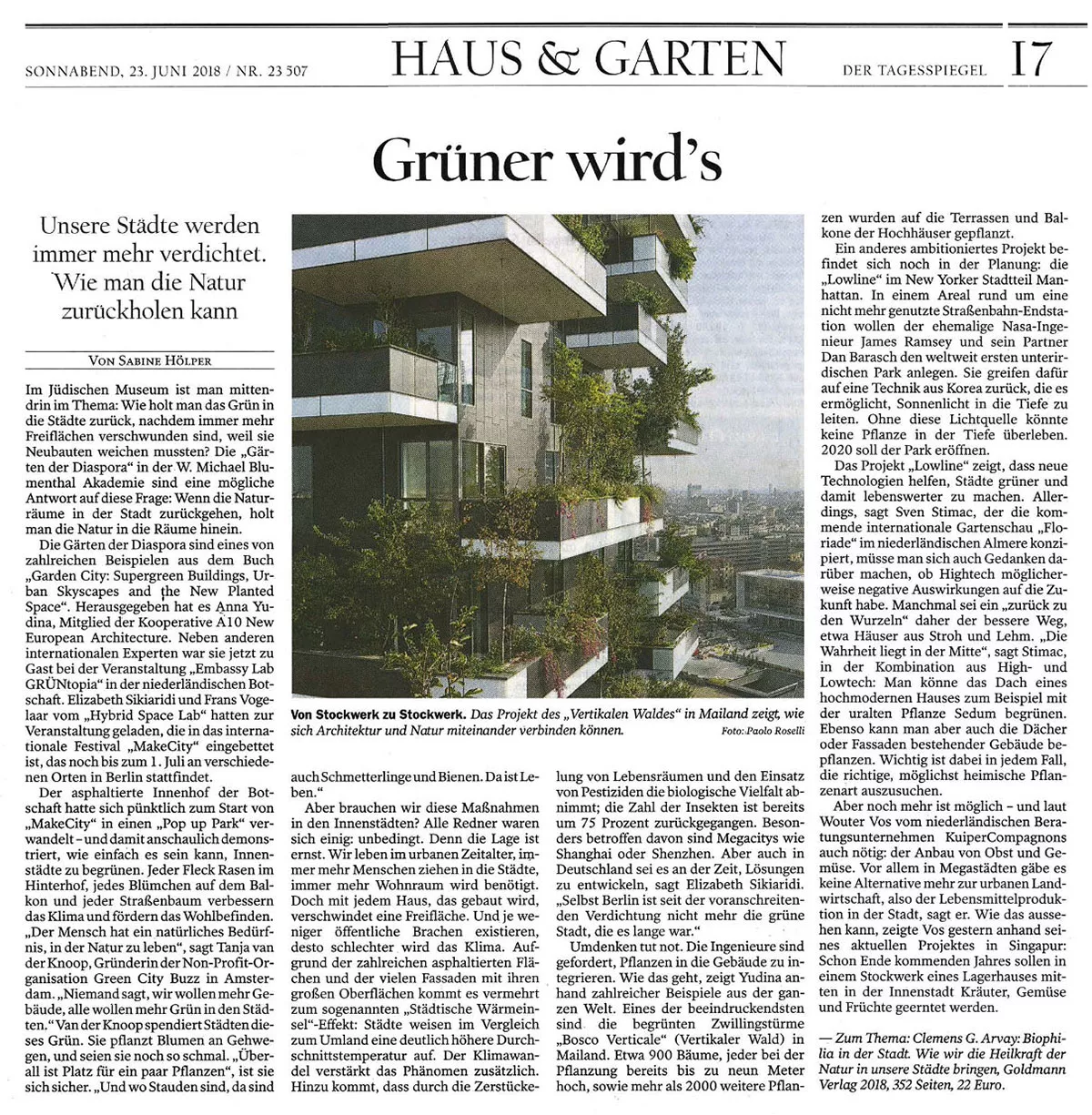The paved courtyard of the Dutch Embassy in Berlin has been turned into a “Pop up Park” just in time for the start of “MakeCity”, clearly demonstrating how easy it can be to green the city.
Among other international experts, Anna Yudina was invited to attend the “Embassy Lab GREEN TOPIA” at the Dutch Embassy, where Elizabeth Sikiaridi and Frans Vogelaar of Hybrid Space Lab invited to the event, which is part of the international festival “MakeCity”.
Publication, Sabine Holper @ Der Tagesspiegel, Berlin, 23 June 2018
In the Jewish Museum you are in the midst of the topic: How to bring the green back to the cities, after more and more open space disappeared, because they had to give way to new buildings?
The “Gardens of the Diaspora” in the W. Michael Blumenthal Academy are a possible answer to this question: When the natural spaces in the city go back, nature gets into the rooms. The Diaspora gardens are one of many examples the book “Garden City: Supergreen Buildings, Urban Skyscapes, and the New Planted Space”. It was edited by Anna Yudina, member of the cooperative A 10 New European Architecture.
Among other international experts, she was invited to attend the “Embassy Lab GREEN TOPIA” at the Dutch Embassy, where Elizabeth Sikiaridi and Frans Vogelaar of Hybrid Space Lab invited to the event, which is part of the international festival “MakeCity”.
The paved courtyard of the Dutch Embassy in Berlin has been turned into a “Pop up Park” just in time for the start of “MakeCity”, clearly demonstrating how easy it can be to green the city. Every patch of lawn in the backyard, every flower on the balcony and every tree in the street improve the climate and promote well-being. “Mankind has a natural need to live in nature,” says Tanja van der Knoop, founder of the non-profit organization Green City Buzz in Amsterdam. “Nobody says we want more buildings, everyone wants more green in the cities.” Van der Knoop donates cities this green. She plants flowers on sidewalks, no matter how narrow. “There’s room for a few plants all over the place,” she says, “and where there are perennials, there are butterflies and bees, there’s life.” But do we need these measures in the inner city? All speakers agreed: absolutely. Because the situation is serious. We live in the Urban Age, more and more people are moving to the cities, more and more living space is needed. But with every house being built, an open space disappears. And the less public green open spaces, the worse the climate gets. Due to the numerous paved areas and the many facades with their large surfaces, the so-called “urban heat island” effect is increasing: Cities have a much higher average temperature compared to the surrounding areas.
With the degradation of habitats and the use of pesticides biodiversity is decreasing, the number of insects has already fallen by 75 percent, particularly affecting megacities such as Shanghai or Shenzhen, but also in Germany, it was time to develop solutions, says Elizabeth Sikiaridi. “Even Berlin, with the progress of densification, is changing – from the green city it has been for a long time.” A rethinking is necessary, engineers are required to integrate plants into the buildings, and Anna Yudina shows how to do this. One of the most impressive is the green twin towers “Bosco Verticale” (Vertical Forest) in Milan. About 900 trees, each up to nine meters high and more than 2,000 other plants were planted on the terraces and balconies of the skyscrapers.
Another ambitious project is still in the planning stage: the “Lowline” in the New York suburb of Manhattan, where former NASA engineer James Ramsey and his partner Dan Barasch want to spread the word around an unused tram terminus. They are using a technique from Korea that allows sunlight to penetrate in deep spaces. Without this light source, no plant could survive in that depth. The park is set to open in 2020. The Lowline project shows that new technologies help make cities greener and more liveable.
However, says Sven Stimac, who designs the upcoming Floriade International Garden Show in Almere, the Netherlands, one must also consider whether high-tech may have a negative impact on the future. Sometimes a “back to the roots” is the better way, such as houses made of straw and clay. “The truth lies in the middle,” says Stimac, in the combination of high and low tech: You can green the roof of a state-of-the-art building with, for example, the ancient plant Sedum. But you can also plant the roofs or facades of existing buildings. In any case, it is important to choose the right, and as far as possible, native plant species. But more is possible – and, according to Wouter Vos of the Dutch consultancy Kuiper Compagnons, it is also necessary: growing fruit and vegetables. Especially in megacities, there is no longer an alternative to urban agriculture, ie food production in the city, he says. What that might look like, Vos showed yesterday on the basis of his current project in Singapore: Already at the end of next year, herbs, vegetables, and fruits are to be harvested on the floor of a warehouse in the city center.
related PROJECTS
